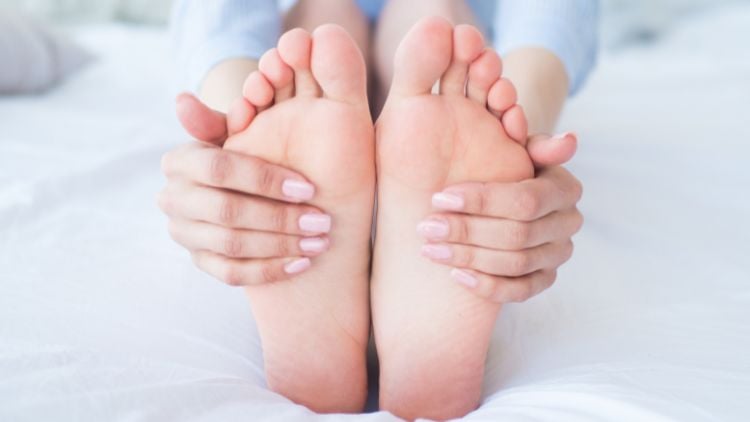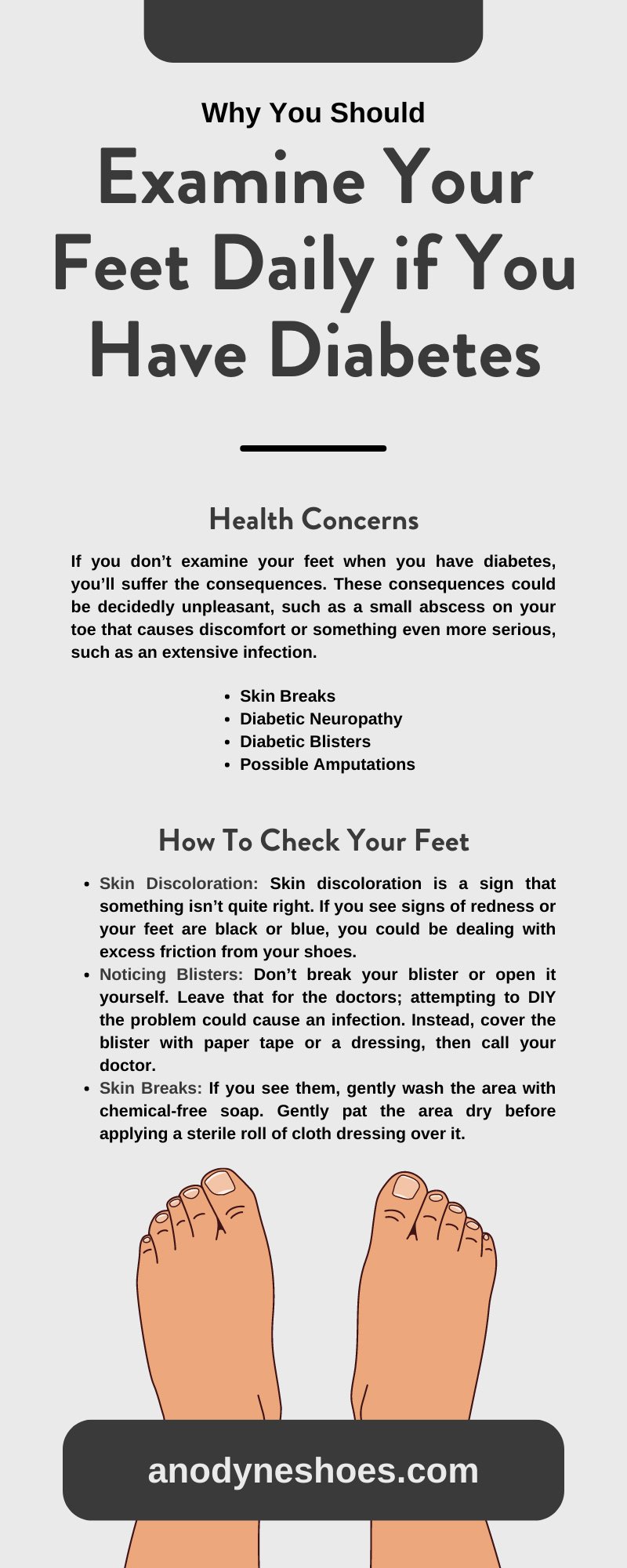
What do you do when your doctor returns to the room and tells you that you have diabetes? While most people view diabetes as less of a health concern than cancer or a stroke, it can be lead to severe challenges. As sugar builds up in your blood, it can damage organs, make you go blind, or even amputate your toes and feet. Since this is the case, you must make many lifestyle changes to stay safe and healthy.
Some of these lifestyle changes are obvious. For instance, exercising and dieting are essential to a healthy life when you have diabetes. However, sometimes the little things will help tremendously as well. One such habit is examining your feet daily if you have diabetes. There are many reasons why you would want to do this. If you don’t check your feet daily, you risk dealing with complications that might lead to infection, amputation, or worse.
So, what should you look out for, and what’s the solution? We’ll teach you about the various health concerns, consequences for not examining your feet, and methods of examination below.
Health Concerns
If you don’t examine your feet when you have diabetes, you’ll suffer the consequences. These consequences could be decidedly unpleasant, such as a small abscess on your toe that causes discomfort or something even more serious, such as an extensive infection. Learn more about the various health concerns you should look out for below.
Skin Breaks
You can experience skin breaks for any reason. Most commonly, a break in the skin stems from a small cut on the foot. It doesn’t even have to be a deep cut. Even a small break in the upper epidermis can get infected. When you have a cut, time is of the essence, and you’re far less likely to develop a serious infection if you check your feet daily. People with diabetes tend to heal slowly, so a core issue of skin breaks is that they’ll become infected over time if unattended. These cuts are especially risky if you walk barefoot through the house—which you aren’t supposed to do. Instead, get some diabetic footwear and diabetic socks.
Diabetic Neuropathy
Heightened blood sugar levels in the body cause diabetic neuropathy. Eventually, your consistently high blood sugar could cause nerve damage. This issue can lead to pain, tingling, and, most important to our discussion, numbness. This numbness is particularly dangerous. For instance, you can step on some glass and not even notice that you have a small cut. That cut could lead to an infection, which can cause many other problems. This is a key reason you should examine your feet daily if you have diabetes.
Diabetic Blisters
Blisters often occur in people who have diabetic neuropathy. They can pop up in many places, including the hands, fingers, feet, and toes. They can even occur on the forearms or legs. Diabetic blisters look just like burn blisters, and they are large. Luckily, they don’t have any redness, and they’re painless. They heal naturally, often without scars, but the healing process can take around three weeks. The only thing you can do to address these blisters is to bring your blood sugar levels under control. However, even though they’re relatively painless, catching them as soon as possible means that you can likely avoid any secondary infections that might come with them.
Possible Amputations
So, what happens if you do get an infection? Well, depending on how far up your leg that infection can travel and how sick it makes you, you might need an amputation. Let’s say you cut your toe, and because you have diabetic neuropathy, you don’t notice it. If you don’t check your feet daily, your foot can become infected without you knowing it. Even worse, sometimes infections mimic some cold symptoms, with feelings of nausea and fever. If this continues without you heading to the podiatrist or treating the infection, it could lead to full-blown amputation. This problem can happen in as little as a week, which is why it’s so important to check your feet.
How To Check Your Feet
Now that we’ve outlined a few key reasons why it’s important to examine your feet daily, we should talk about how to check your feet and tell if something is amiss.
Skin Discoloration
Skin discoloration is a sign that something isn’t quite right. If you see signs of redness or your feet are black or blue, you could be dealing with excess friction from your shoes. Alternately, if your feet feel hot—which is more likely to occur during the summer—it could be an early sign of blood flow problems. The key is to wear a shoe that fits you with enough circulation so that your feet have room to breathe.
Noticing Blisters
This is another sign that you need a new pair of shoes. Blisters are also caused by your feet rubbing against the fabric material, so make sure you get new footwear and moisture-wicking socks if this issue persists. Before you go to the doctor for blisters, let’s give you a few pointers. Don’t break your blister or open it yourself. Leave that for the doctors; attempting to DIY the problem could cause an infection. Instead, cover the blister with paper tape or a dressing, then call your doctor.
Skin Breaks
The most common places you’ll notice skin breaks are under and between your toes. It’s also not uncommon to see them on the soles of your feet. If you see them, gently wash the area with chemical-free soap. Gently pat the area dry before applying a sterile roll of cloth dressing over it.
Perception of Numbness
Sometimes, you may sit in a position that temporarily cuts off blood circulation to an area. If you shift your position and still feel numbness, it might be time for a trip to the doctor, especially if the issue occurs for an extended period. This is an early warning sign of diabetic neuropathy, which isn’t reversible.
Foot Ulcers
Don’t try and treat your ulcer at home. A large sore in your foot can become easily infected, so the best thing you can do is keep the area clean. Unlike diabetic blisters, these ulcers don’t go away on their own. They’re far more likely to get worse over time, so see your podiatrist and make sure they treat it as soon as you can. Untreated ulcers could lead to infection, illness, and amputation.
These are just a few reasons you should examine your feet daily. However, the best defense is an offense in these cases. If you want to protect your feet, especially around the house, consider some of our gentleman’s and ladies’ diabetic slippers. They’re perfect for protecting your feet throughout the day. Contact us for more information, or shop at our online store!



.png?width=116&name=Anodyne_circle_1_logo%20(2).png)
